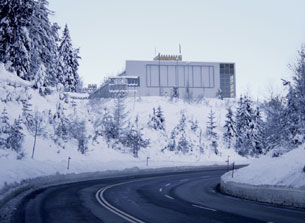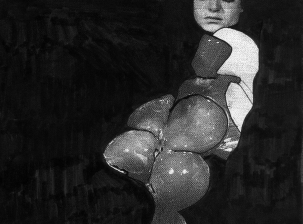 |
|
   |
|
 |
|
 |
|
 |
|
 |
|
 |
|
|
Carola
Dertnig |
|||||
|
|||||
|
Opening:
Friday, February 3, 2006, 7 p.m. Exhibition will be
opened by Dr. Erwin Koler, head of the Tyrolean government’s
office for cultural affairs |
||||
|
Carola Dertnig’s thought, research and artistic work revolves around the performative. Texts, images, live actions and videos merge forming different performative layers in which Dertnig focuses on juxtaposing familiar aspects with the neglected back sides and alternative models. The artist is usually the protagonist in her works, mainly in her videos. At the same time she studies and reflects on the performative strategies from recent decades, with critical, feminist oriented perspectives as well as a clear interest for the politicization of gender as central aspects of her work. The exhibition will present a broad cross-section of Dertnig’s artistic work which also foregrounds the locations the artist has a specific relation with. The Seefeld
Triology is
dedicated to the place where Dertnig spent part of her childhood in the
small bed and breakfast inn which her grandmother ran. In three
different works, Dertnig studies the processes that were triggered by
tourism, each of which marked by contradictory collective and private
utopia. In Haus Jenewein, the artist focuses on a
house built in 1932 by the architect Siegfried Mazagg, a building which
serves as an excellent illustration of modernist construction in alpine
areas. This house, which was torn down several years ago, has meanwhile
yielded to an apartment block constructed in the typical
“Tyrolean style”. Dertnig tries to reconstruct the
history of this house along with the implications of its destruction. The piece …but buildings can’talk… is composed of a series of drawings, photographs and texts which Dertnig made in the summer of 2001. The buildings that “converse” here are the towers of the World Trade Center personified in the form of drawing. Her theme is the 1993 attack on the WTC. Since Dertnig had had a studio on the 91st floor in one of the twin towers, her relation to the building was indeed a special one. In a series of photographs she documents the empty office spaces – some of them devastated –, documenting the sudden departure of the tenants due to economic reasons. …but buildings can’talk… is an ironic-endearing metatext on the city of New York. The attacks of 9/11 cast a new light not just on the city but also on Dertnig’s work. In the video A room with a view in the financial district the pictures, shot with the photo button of a video camera, show deserted (dot.com) offices in the World Trade Center. Dertnig combined these clear shots, which play with the format commonly used in documentary photography, with a first-person off-camera narration. Observations concerning economic structures and the circumstances of personal lives, artistic production and financial power, surveillance methods and empty spaces which are both mobile and available flow together in a circling dynamic. (Rike Frank) The protagonist Lora Sana of the eponymous photography and video piece which Dertnig put together from the commented interviews with former women participants in Viennese Actionism, conveys aspects of canonized art history that have remained unpopular and the therewith related shaping of the identity of Viennese Actionism. Dertnig relinquishes the fictional, documentary distance to this art movement and integrates it in contemporary discourse by focusing on the female “models” of the actionists that have received little attention. Dertnig covered parts of the action photographs by drawing over, thus creating a different view of the legendary images. By drawing, the new piece became a documentation of a further action, of a performative intervention. In the video slapstick series True Stories (1997–2003) shown completely for the first time in the exhibition, Dertnig’s sensitivity of apprehension, her precise implementation and her humor culminate in an exceptional way. The publication Let’s twist again (Dea Verlag) produced together with Stefanie Seibold is scheduled to appear in February 2006. The documentation focuses especially on those manifestations of performance since 1960 that have been largely ignored in official art historical accounts in spite of their significance for the scene. Carola Dertnig lives and works in Vienna. A catalogue is to appear for the exhibition. It will be presented on the occasion of a lecture. |
|||||
 |
Lecture
and catalogue presentation Michael Zinganel Catalogue Thanks go
to the following persons |
||||
|

